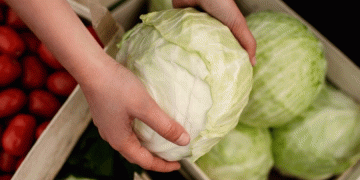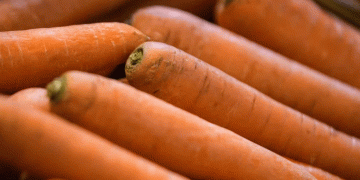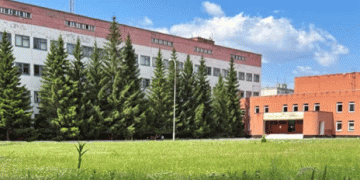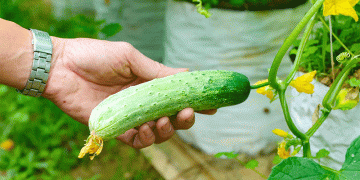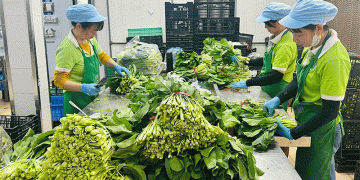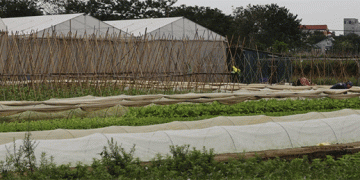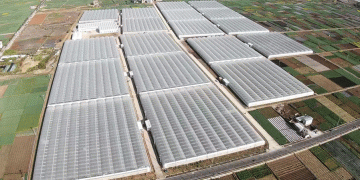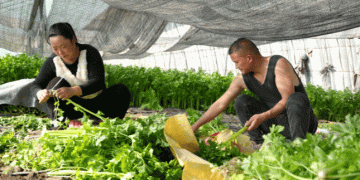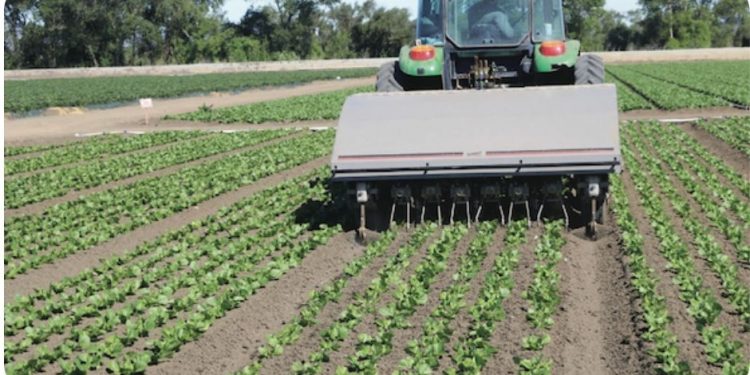The Great Lakes Fruit, Vegetable & Farm Market EXPO was quite a treat this year.
I felt the energy around and within me – after a year or two without conferences I didn’t realize how much I missed being around other growers and ag professionals. It sure felt good.

Dan Brainard at Michigan State University Horticulture pulled together some of our region’s best and brightest to talk about weed control, and through the magic of technology we also got to hear from an expert in California. In this article I’ll describe the basic types of robotic weeders, examples of what they are capable of and how they are being used commercially in California.
Steve Fennimore from University of California, Davis works with growers who use these weeding robots in vegetables. First he made a few distinctions between the different types of robotic weeders. The first, with the lowest level of complexity, are camera-guided hitches (photo 1). These are towed behind a tractor by the three-point hitch and the toolbar is moved left and right (perpendicular to the direction of travel) by hydraulic cylinders. The movement is controlled by cameras that “see” the crop, keeping the tools centered on the crop row. Camera-guided weeders merely keep traditional weeding tools centered on the row.
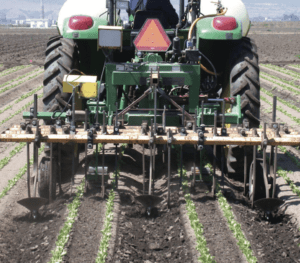
Next, with an intermediate level of complexity, are tractor-mounted in-row robotic weeders (photo 2, pictured at top). These are also towed behind the tractor by the three-point hitch, however, they do not use traditional weeding tools, rather, there is a camera for each row and the camera guides a piece of steel moving in between individual plants. Tractor-mounted in-row robotic cultivators need a person to drive the tractor or to control it.
The final type of weeding robot, with the greatest level of complexity, are autonomous robotic weeders (photo 3). These machines do not need a tractor or operator and once a field map is inputted they move on their own through the field for hours at a time, day or night. For now these autonomous robotic weeding machines can carry traditional weeding tools (sweeps, finger-weeders, etc.) and not the camera-controlled blades that weed in between each plant.
Fennimore has conducted a lot of trials, and he shared his data about the time required for each tool. Growing an acre of lettuce costs about $439 per acre to weed. Of this total weeding time, hand weeding requires 68%, 9% is for tractor cultivation, and 22% is herbicide application. Hand weeding is the major cost of weed control.
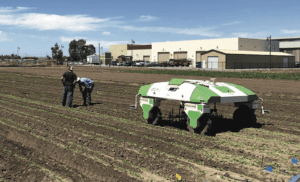
Fennimore identified three different robotic weeders that are being used in California. The Stout (photo 2) is a tractor-mounted in-row robotic weeder. The Titan (photo 4) is also a tractor-mounted in-row robotic weeder but it comes with its own tractor, and the Dino is an autonomous robotic weeder with traditional tools (photo 3). Fennimore shared the results of trials completed by him and Richard Smith showing what these three machines can do.
The machines’ performance was variable (just like farming). For example in one trial in a commercial field the Titan machine removed 69% of the weeds in the row and reduced hand weeding time by about half (compared to traditional between-row cultivation), but in another trial it removed only 31% of weeds in the row and reduced hand weeding time by about 10%.
In another research trial, between-row tractor cultivation removed 66% of weeds on the bed-top and the Titan removed 91%. In this trial the Titan reduced hand weeding by about half compared to between-row tractor cultivation. In another commercial field trial the Stout removed 98% of in-row weeds and reduced hand weeding time by about half compared to between-row tractor cultivation (although in another pass it reduced weeds by 52% – again, results are variable). The Dino was fitted with finger weeders, and it removed 61% of weeds compared to between-row tractor cultivation that removed 41% of weeds.
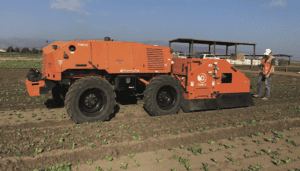
Fennimore was impressed with the ability of these machines to operate accurately in fields with high weed densities. In July, there was a lettuce field overrun with purslane (photo 5). He thought they had to cancel the trial because the computer could not tell the difference between the lettuce plants and weeds, but the Stout company figured it could do it. The standard tractor cultivation effectively removed none of the weeds in the row, but the Stout removed 76% of in-row weeds. With the high weed density it took a long time to make it through the field – the standard tractor cultivation required 78 hours per acre whereas the Stout needed 30 hours per acre. Although in general, growers around Steve have found that tractor-mounted robotic weeders can cultivate a 10-acre field in 8-10 hours.
Fennimore said that as an Extension specialist he cares about production costs; even if these robotic weeders work wonders, if they increase production costs by too much, they aren’t good for growers.
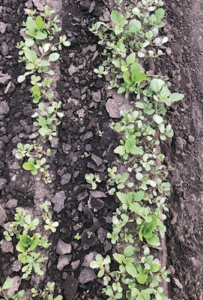
He cited a study comparing the costs of robotic weeders to hand weeding in lettuce (Tourte et al., in review). They figure that it costs on average $161 per acre to hand weed lettuce. Then they figured the costs for three different types of tractor-mounted in-row robotic weeders – they varied from $166-$204 per acre (including a tractor, operator, cost of machine and maintenance). Use of these machines could reduce hand weeding costs to $100 per acre, but overall costs for weed control using the robotic weeders ranged from $266-$304 per acre.
This means that using robotic weeders costs more than hand weeding. So why are some growers in California adopting these robotic weeders?
Fennimore did some research and thinking to figure out why. He found a survey of CEO’s asking them why they want to adopt technology (Economist, 1/16/21). They said that machines can reduce risk (fewer people get hurt), be more reliable than employees and help with making costs more predictable. Additionally, herbicides are showing diminishing returns and fewer young people aspire to be hand weeders.
Because these robotic weeders require investment (a standard Stout model is $350,000) some companies contract out the use of the machine – much like how you would hire out a custom sprayer or harvester.
For now, these autonomous robotic weeders and tractor-mounted in-row robotic weeders are concentrated in our nation’s largest vegetable-producing areas in Southern California and Arizona. But I spoke with the CEO of Stout, Brent Shedd, and he tells me that they have machines in Florida and Georgia, and interest from the Midwest. So we will see how these robotic weeders spread.
— Sam Hitchcock Tilton, VGN correspondent















